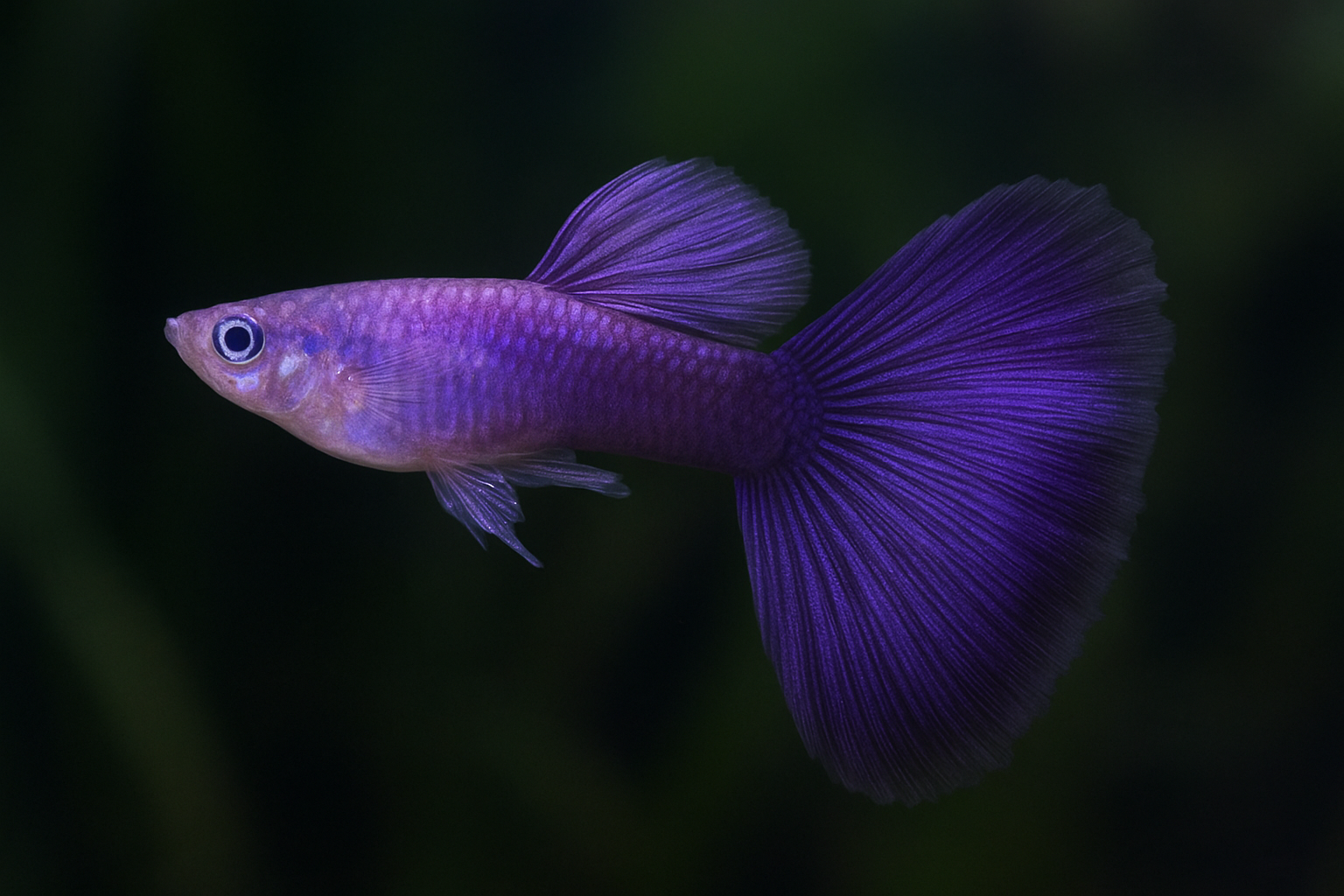The Purple Grass Guppy is one of the most stunning and sought-after guppy varieties in the aquarium trade. Its mesmerizing shades of purple, often blended with delicate grass-like tail patterns, make it a prized possession for both beginner and expert fish keepers. Known for their active swimming, easy breeding habits, and peaceful nature, Purple Grass Guppies are not just visually appealing but also highly adaptable to different aquarium environments.
In this comprehensive guide, we will explore everything you need to know about Purple Grass Guppies, including their origin, appearance, care requirements, breeding tips, feeding habits, common diseases, and expert tricks to keep them healthy and vibrant.
Origin and History of the Purple Grass Guppy
The guppy species (Poecilia reticulata) originates from the freshwaters of South America, particularly in Venezuela, Guyana, Barbados, and Trinidad and Tobago. Over decades, selective breeding by aquarists around the world has produced hundreds of guppy strains with unique colors and fin shapes.
The Purple Grass Guppy is a selectively bred variant, created by combining guppies with grass-patterned tails and strong purple pigmentation. While purple is not a natural guppy color in the wild, skilled breeders have developed stable purple lines by enhancing red and blue pigments through generations of crossbreeding.
Appearance and Unique Features
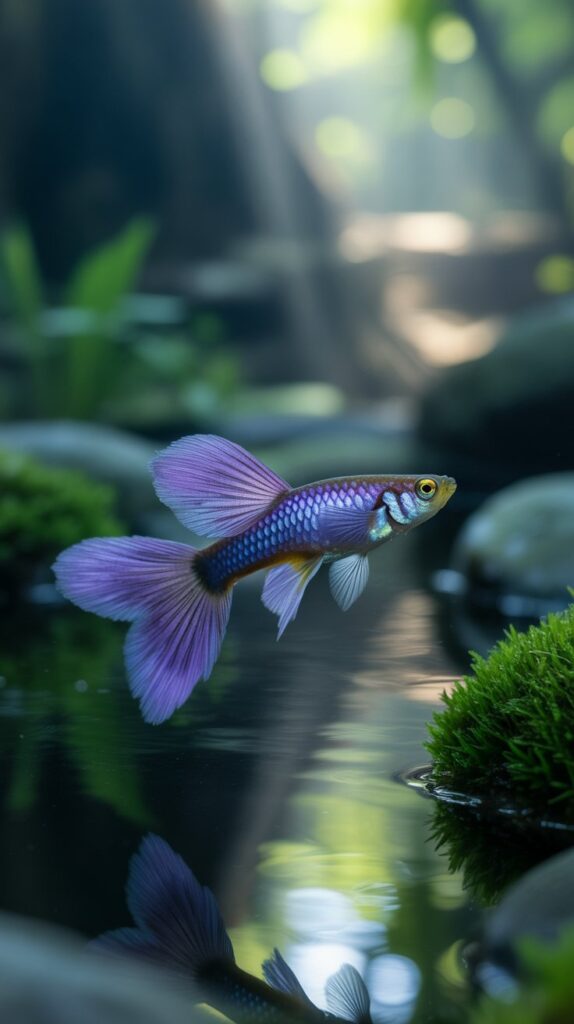
The Purple Grass Guppy stands out due to its:
- Coloration: A rich, shimmering purple hue covering the tail and sometimes extending to the dorsal fin and body.
- Grass Pattern: The tail fin has fine, hair-like streaks resembling blades of grass, often in dark or black shades, creating a striking contrast with the purple base.
- Tail Shape: Usually fan-shaped or delta, although some strains have a lyretail or roundtail variant.
- Size: Males typically grow up to 1.5–2 inches, while females can reach 2.5 inches.
- Sexual Dimorphism: Males are smaller but more vibrantly colored, while females are larger with rounder bellies.
Why Purple Grass Guppies Are Popular Among Aquarists
- Unique Coloration – The deep purple tones are rare in the aquarium hobby, making them a collector’s favorite.
- Peaceful Nature – They coexist well with most community fish.
- Easy to Breed – Ideal for beginners who want to experience livebearer breeding.
- Hardy and Adaptable – They tolerate a wide range of water parameters.
- Active Swimmers – They bring movement and life to the tank.
Tank Requirements for Purple Grass Guppies
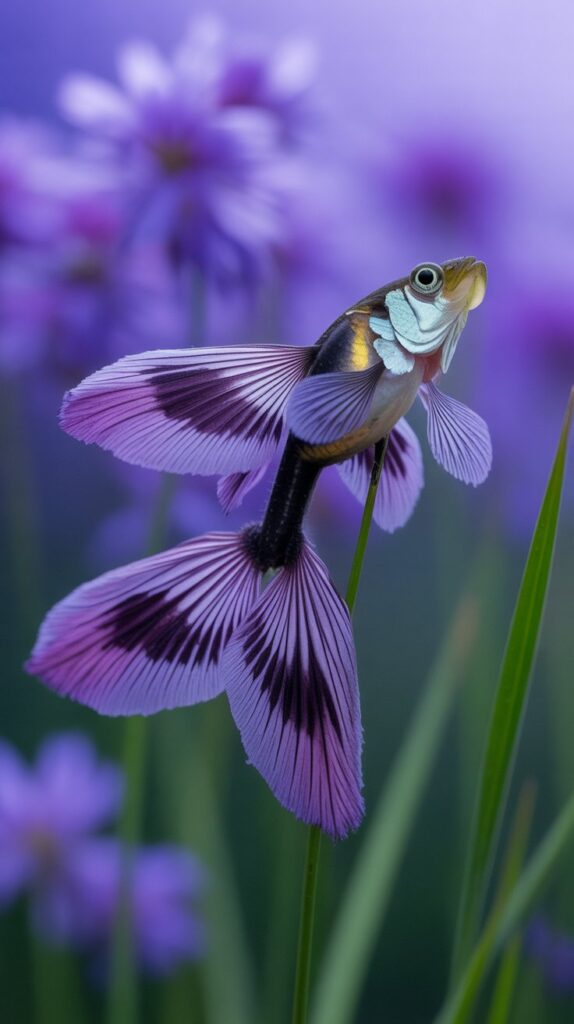
To keep Purple Grass Guppies healthy and vibrant, you must provide the right aquarium setup.
1. Tank Size
- A minimum of 10 gallons is recommended for a small group.
- Larger tanks (20 gallons or more) are better for breeding colonies.
2. Water Parameters
- Temperature: 72°F–82°F (22°C–28°C)
- pH: 6.8–7.8
- Hardness: 8–12 dGH
- Maintain stable conditions to avoid stress and disease.
3. Filtration and Aeration
- Use a gentle sponge filter or hang-on-back filter to ensure clean water without strong currents.
- Moderate aeration is recommended for oxygen supply.
4. Lighting
- Moderate lighting enhances their purple colors.
- Too much light can cause algae growth, so balance is key.
5. Substrate and Decorations
- Fine gravel or sand substrate.
- Plants like Java moss, hornwort, and guppy grass provide hiding spots for fry.
- Add driftwood and small caves for aesthetics and shelter.
Feeding the Purple Grass Guppy
Purple Grass Guppies are omnivorous and require a varied diet for vibrant colors and healthy growth.
Diet Recommendations
- High-Quality Flakes/Pellets – Base diet for daily feeding.
- Live Foods – Brine shrimp, daphnia, mosquito larvae for breeding conditioning.
- Frozen Foods – Bloodworms, tubifex worms.
- Vegetable Matter – Blanched spinach, spirulina-based flakes.
Feeding Tip:
Feed small amounts 2–3 times daily and avoid overfeeding to maintain water quality.
Breeding Purple Grass Guppies
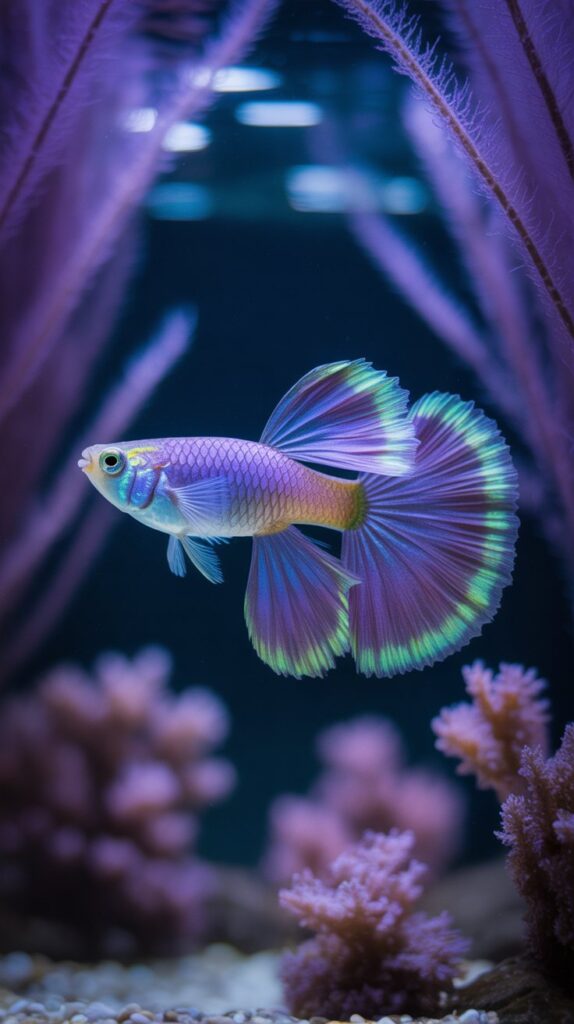
Breeding Purple Grass Guppies is one of the most enjoyable experiences for aquarists.
1. Breeding Setup
- Use a separate breeding tank (10–15 gallons).
- Add plenty of live plants for fry protection.
2. Male-to-Female Ratio
- Ideal ratio: 1 male to 2–3 females to prevent female stress.
3. Gestation Period
- Females give birth every 25–30 days.
- A single drop can produce 20–60 fry.
4. Fry Care
- Remove adults after birth to avoid predation.
- Feed fry with crushed flakes, infusoria, or baby brine shrimp.
- Keep water clean and warm for faster growth.
Common Health Issues and Prevention
Like all guppies, Purple Grass Guppies can face certain health problems if not cared for properly.
1. Fin Rot
- Cause: Poor water quality or fin damage.
- Prevention: Keep the tank clean, avoid sharp decorations.
2. Ich (White Spot Disease)
- Cause: Parasitic infection due to temperature fluctuation.
- Prevention: Maintain stable water parameters.
3. Dropsy
- Cause: Internal bacterial infection.
- Prevention: Avoid overfeeding and maintain good filtration.
4. Swim Bladder Disorder
- Cause: Overfeeding or infection.
- Prevention: Feed in moderation and provide a balanced diet.
Tips for Enhancing Purple Grass Guppy Colors
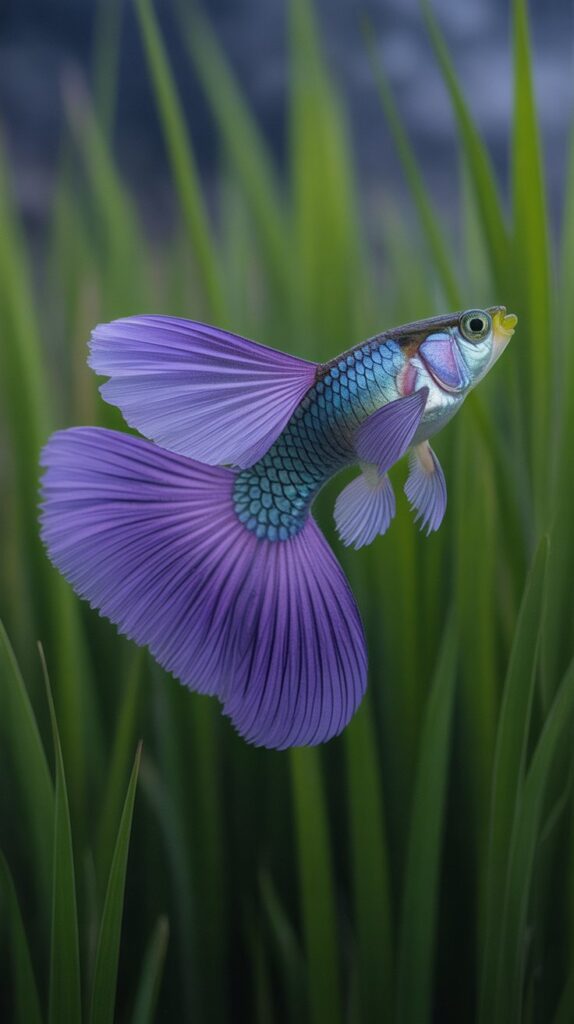
- Provide a high-protein diet with color-enhancing foods like spirulina and krill.
- Maintain pristine water conditions with regular water changes (20–30% weekly).
- Keep them in a planted aquarium for natural comfort and reduced stress.
- Avoid keeping them with fin-nipping species that may damage their tails.
- Selectively breed only the most vibrant individuals to maintain strong coloration.
Tank Mates for Purple Grass Guppies
Purple Grass Guppies are peaceful and get along with most small, non-aggressive fish.
Recommended Tank Mates:
- Neon Tetras
- Corydoras Catfish
- Mollies
- Platies
- Harlequin Rasboras
- Endler’s Livebearers
- Cherry Shrimp and Snails
Avoid:
Aggressive fish like tiger barbs, bettas, and large cichlids that may harass or eat guppies.
Purple Grass Guppy Price and Availability
The price of Purple Grass Guppies depends on their quality, size, and source:
- Average Price: $3–$10 per fish
- High-Grade Show Guppies: $15–$30+
- Available in local aquarium shops, online guppy breeders, and fish auctions.
Purple Grass Guppy Maintenance Checklist
✅ Weekly water change (20–30%)
✅ Test water parameters regularly
✅ Remove uneaten food after 5 minutes
✅ Trim plants if overgrown
✅ Observe fish daily for signs of illness
✅ Clean filter media monthly without killing beneficial bacteria
Conclusion
The Purple Grass Guppy is a true gem in the aquarium hobby, combining rare purple hues with an elegant grass-like tail pattern. Their beauty, ease of care, and playful nature make them a favorite for both beginners and expert aquarists. With the right tank setup, balanced diet, and proper breeding care, you can enjoy a thriving and colorful guppy colony for years to come.
If you’re looking to add a touch of elegance and vibrant life to your aquarium, the Purple Grass Guppy is an excellent choice.
FAQs About Purple Grass Guppies
1. Are Purple Grass Guppies beginner-friendly?
Yes, they are hardy and adaptable, making them perfect for beginners.
2. How long do Purple Grass Guppies live?
With proper care, they can live for 2–3 years.
3. Do Purple Grass Guppies need a heater?
Yes, especially in cooler climates. They thrive in 72–82°F (22–28°C).
4. Can I keep Purple Grass Guppies with bettas?
Not recommended, as bettas may nip their fins.
5. How often should I feed Purple Grass Guppies?
Feed them small portions 2–3 times a day.
6. Will Purple Grass Guppies lose their color?
Poor diet, stress, and bad water conditions can dull their colors. A healthy environment maintains their vibrancy.
7. How can I tell male from female Purple Grass Guppies?
Males are smaller, colorful, and have a pointed anal fin (gonopodium). Females are larger with rounder bellies.
8. Can Purple Grass Guppies survive without a filter?
They can survive temporarily, but a filter is essential for long-term health.
9. How many Purple Grass Guppies should I keep together?
At least a group of 6 or more to encourage natural behavior.
10. Do Purple Grass Guppies eat their fry?
Yes, adults may eat fry, so provide hiding spots or separate them after birth.

